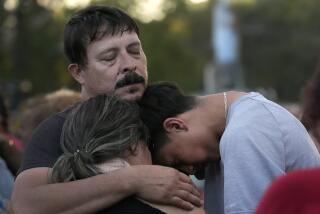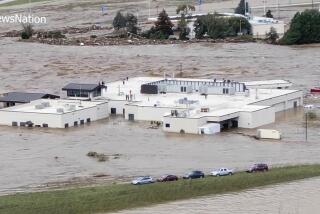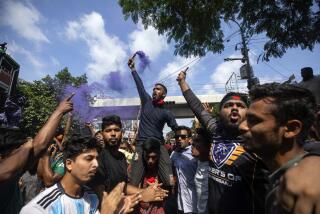Protests in Bangladesh as death toll from building collapse rises
- Share via
NEW DELHI, India -- The death toll in Bangladesh rose to more than 300 people Friday following the collapse this week of a building that housed five apparel factories, officials said, as protests by workers at other garment plants intensified.
Bangladesh police fired tear gas and rubber bullets as hundreds of stick-wielding workers in the Dhaka area stopped highway traffic, smashed vehicles and vandalized garment factories that refused to close during a declared day of mourning. Traffic was clogged for hours as demonstrators, some waving black flags, called for the arrest and punishment of the owner of Rana Plaza, which collapsed Wednesday morning just outside Dhaka, the capital.
Television footage showed demonstrators smashing the windows of a red city bus and throwing stones at shuttered shops as thick black smoke poured from a building housing two garment factories, several shops and an ATM booth. At least 70 people were reportedly injured in clashes, including several fire and police officials.
Photos: More than 300 dead in building collapse
The nine-story Rana Plaza, a building with 300 shops on the lower levels in addition to the upper-floor factories, was designed as a five-story building, but its owner added three floors and was building a fourth, according to local media. Workers reportedly noticed serious cracks Tuesday but were told it was safe and ordered to return to their sewing machines.
“In some countries, people get prison for that,” said Jyrki Raina, general secretary of the IndustriAll Global Union, a Switzerland-based labor group. “These guys should be jailed.”
By Friday afternoon, 2,348 people had been rescued, including 72 people pulled out of the debris that day, Shahinur Islam, a spokesman for the defense department, told journalists. Most of the bodies that had been recovered were delivered to families, authorities said, while 26 unidentified corpses were sent to the morgue.
Two babies were born under debris after their pregnant mothers were trapped in the ruins, a fire service official said. The mothers and newborns were rescued alive.
In an indication of impoverished Bangladesh’s low living standards, government compensation was set at $256 for the families of each of the dead and $64 for each injured person.
With many still trapped under mountains of twisted steel and jagged concrete, rescuers feared the death toll would rise further. The five factories employed 3,122 workers, according to the Bangladesh Garment Manufacturers and Exporters Assn.
Bangladesh’s High Court on Thursday issued a summons to the building owner and owners of the textile plants ordering them to appear by Tuesday. On Friday, the Labor and Employment Ministry filed five cases in labor court against them.
But some expressed skepticism that the owners would be prosecuted.
“Some of the high-ups of this government have an interlocking relationship with factory owners,” said Ataur Rahman, a political science professor at the University of Dhaka. “If you judge from the past, there’s been a half-dozen major incidents including workers burnt alive like they were in an oven, and nothing was ever done.”
In November, 112 workers died in a garment factory fire with locked fire exits. According to the Bangladeshi Garment and Industrial Workers Federation, more than 10% of the country’s 350 lawmakers have ownership stakes in garment factories.
Human Rights Watch, a New York-based group, said in a report Thursday it knows of no case in which the Bangladesh government has prosecuted a factory owner over the death of workers.
Friday’s violent demonstrations reflect frustration by employees over watered-down work rules and safety standards, given the close links between factory owners and the ruling party, Rahman said. In a case in point, he added, Rana Plaza’s owner, Sohel Rana, is a top official in the youth wing of the ruling Awami League party.
“Worker demands for better wages and working conditions are unfulfilled by the factory owners, who are very ruthless people and don’t want to change,” Rahman said. “The relations of owners with the government is very close. Many suspect they won’t even be arrested. The workers are really shouting for this.”
Human Rights Watch said the government hasn’t made factory oversight a priority. In June 2012, the labor ministry’s inspection department had 18 inspectors to police an estimated 100,000 factories in Dhaka district. The garment industry has approximately 4,500 factories, employs around 4.2 million workers and accounts for a whopping 80% of the country’s $24 billion in exports.
In Washington, U.S. State Department spokesman Patrick Ventrell said Thursday that this week’s accident underscores the urgent need for the Bangladesh government, factory owners, buyers and workers to find ways of improve working conditions.
ALSO:
Three men sentenced in Britain for terrorist plot
‘Lone wolf’ terrorists get what they want in global spotlight
Six Afghan policemen poisoned, shot to death; seventh is missing
Tanvi Sharma in the New Delhi bureau contributed to this report.
More to Read
Sign up for Essential California
The most important California stories and recommendations in your inbox every morning.
You may occasionally receive promotional content from the Los Angeles Times.










